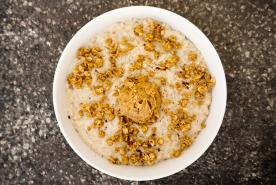January 20, 2023
Continuing education series for professionals.
How much protein someone with kidney disease should have is a commonly asked question that can be difficult to answer. A panel of interprofessional healthcare providers breaks it down by providing a basic overview of protein, sharing current guidelines, and giving patient education tips.
Different types of protein
Protein is one of three macronutrients humans need to survive and comes in two forms: animal and plant protein.
"Most of the protein we eat comes from meat like fish or poultry, but you'll find smaller amounts of protein in things like grains and vegetables," said Melanie Becks, a kidney dietitian. "Plant proteins are easier on the kidneys because they tend to create less acid during metabolism– either a net zero or negative acid load, whereas animal proteins tend to have a huge acid load."
The consequences of a high-protein diet and a large acid load can be severe.
"High protein can cause intraglomerular hypertension which results in glomerular hyperfiltration and glomerular injury. Some proteins may produce more acid than others which increases ammonia genesis and overall work of the kidney," said Dr. Bryan Tucker. "It is also associated with more tubulointerstitial injury, which may be attenuated with a low protein diet."
Become a member to access more clinical resources developed for renal dietitians.
Protein intake guidelines for people with kidney disease
Recommendations change based on a patient's individual health situation and stage of kidney disease.
"Limiting protein in the earlier stages can help slow the progression of kidney disease," said Becks. "People who are on dialysis have higher than average protein needs because the process tends to break down a lot of the protein in the blood."
“To meet protein requirements, some people may use a keto acid analog,” said nephrology nurse practitioner, Tammy Poma. “It's a nitrogen-free essential amino acid used for patients not on dialysis and without diabetes.”
Learn more with the KDOQI Clinical Practice Guideline for Nutrition in CKD 2020 update.
Overcoming common roadblocks

Knowing the guidelines and following them are two different things. Healthcare professionals must understand the social determinants of health, different learning styles, and how difficult behavior changes can be to create solutions that work long-term.
"Try to be understanding of what your patients are going through," said Akilah King, LCSW. "Some may experience food insecurity, which can look like reducing food intake, limited access to grocery stores, or having lower quality groceries. We need to consider physical accessibility, whether that's modes of transportation or disabilities that our patients have. Health literacy levels are also important to take into account."
Education is crucial, but professionals must adjust their teaching methods based on how people learn. Some may need conversations, while others require physical handouts or food models. For Dwayne Clayton, a peritoneal dialysis patient, various techniques helped him meet his protein requirements.
"When I was on dialysis I was given sample examples of foods that were high in protein. I was given charts and shown what a proper serving of protein would look like," said Dwayne. "I learned to read labels and I was shown my labs so I could have a better understanding of what a healthy range is."
Changing behavior can be complicated because even one change could involve many life adjustments to achieve it. Remember, slow and steady wins the race.
Three resources that may help your patients make these changes:
- Plant-Based Diets and Kidney Disease
- How to Read a Comprehensive Metabolic Panel
- Meal Prepping 101 for Kidney Disease
"I would recommend going slow, not overwhelming the patient with all these recommendations," said Dr. Tucker. "Start with one or two small dietary changes every visit. Continue adjusting this based on patient progress to see how the patient is doing."
Take the Protein in Diet of Kidney Patients continuing education test.
Earn CE On the Go
Listen and earn CE as our panelists delve into the subjects that matter most to you while offering in-depth clinical updates and real-world examples of these changes. Subscribe to The Kidney Commute Podcast.


















